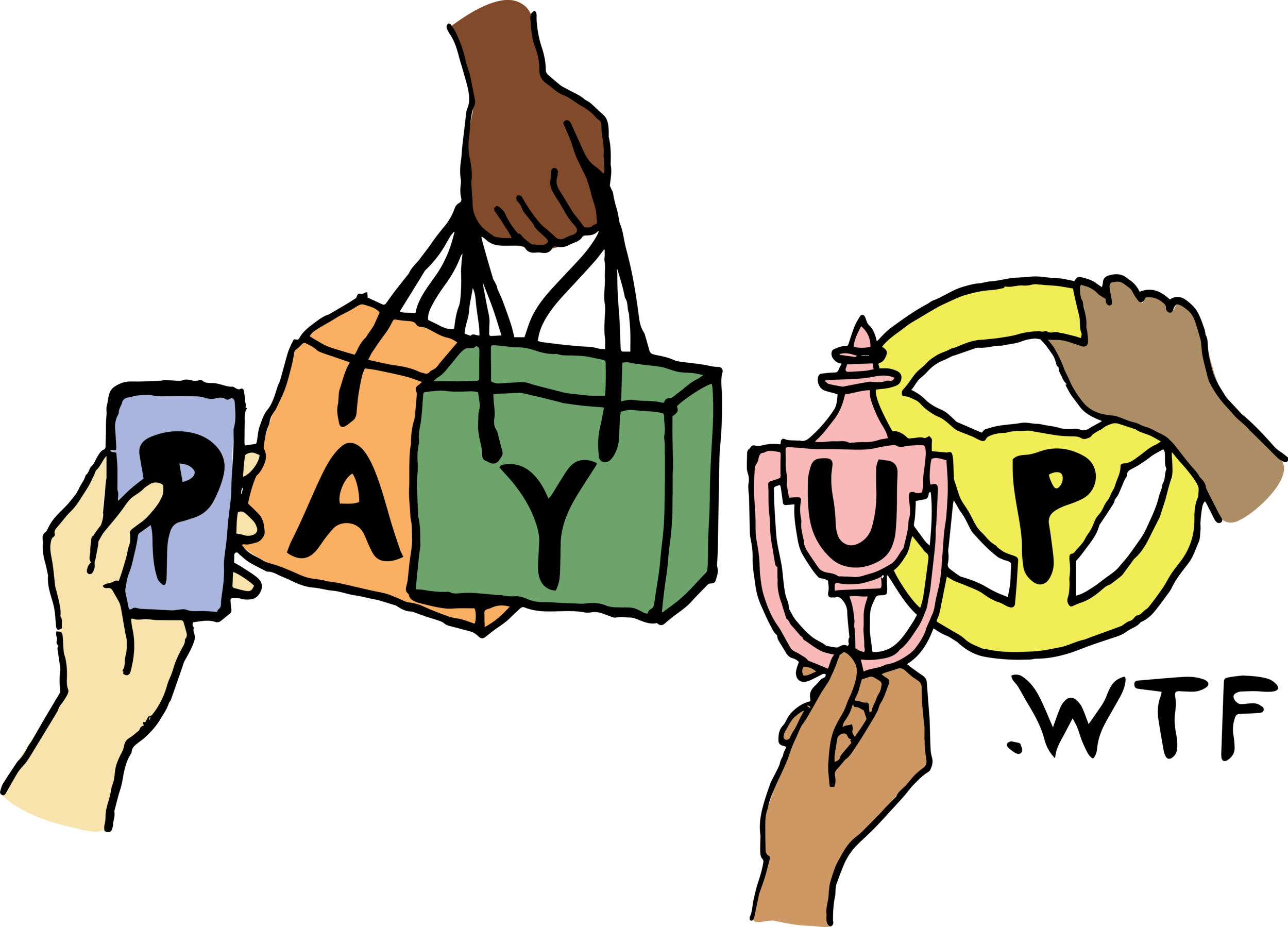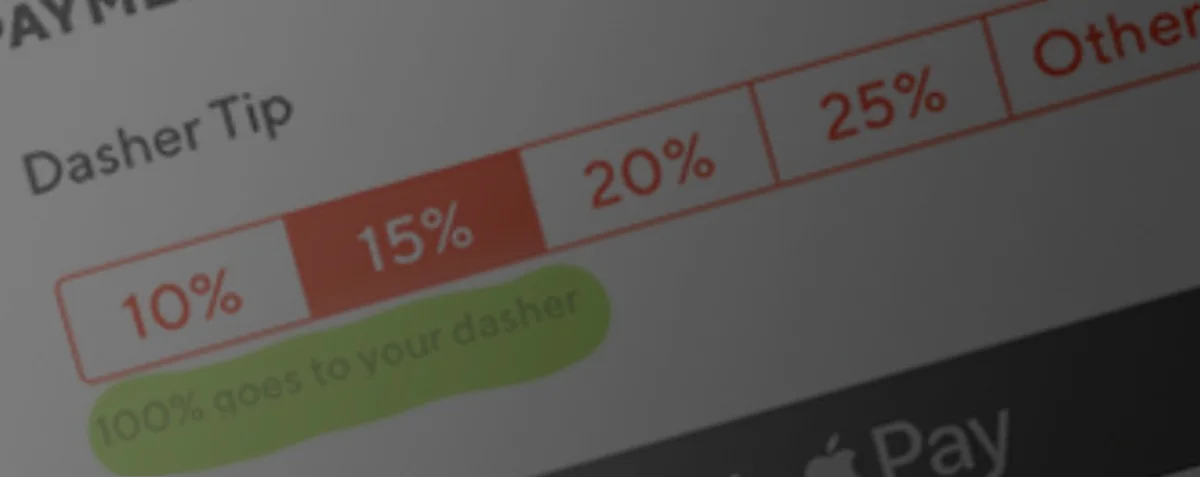Instacart workers with Working Washington recently exposed some emerging pay practices in the gig economy which take tips intended for workers and divert them to the corporate bottom line. While different companies have taken somewhat different approaches (and Instacart reversed its practice under pressure from workers and the public) many of these approaches seem designed to mislead customers. The strong presumption of any customer when they add a tip is that the money will be in addition to base wages; but under these tip-taking pay models, every dollar a customer tips simply reduces what the companies pay that same worker by a dollar. In these situations, tips aren’t providing extra money to workers, they’re replacing pay from companies.
In other words, tips are being used as a substitute for wages, not a supplement — meaning that in effect, customers are tipping companies. Here’s a look at various gig economy pay models and how they handle tips.
DoorDash
When DoorDash offers workers a job, they provide a “guaranteed minimum” for that job. This minimum is determined by a black-box algorithm that supposedly takes into account a variety of factors, including distance, typical wait time at the restaurant, number of items, and more. The guaranteed amount is inclusive of customer tips, and the amount coming from DoorDash is not distinguished from the amount coming from the tip. In fact, even though customers tip up-front on DoorDash (i.e. before delivery) that basic information about where the money is coming from is not available to workers. The offered amount is also inclusive of mileage, leading to some “guarantees” which are less than zero when you take mileage rates into consideration, even inclusive of tip.
DoorDash’s policy provides that at least $1 will come from the company, plus tips, and that workers will get at least the guaranteed amount for that job. But by design, it is effectively impossible for the worker to know how much DoorDash is actually paying for a given job, and how much comes from tip.
The impact of the “guaranteed minimum” being inclusive of tip is that increasing the tip does not increase workers’ pay. Instead, each additional dollar of tip from a customer simply lowers the company’s contribution to pay by a dollar. (If the customer tips so high that it would reduce DoorDash’s contribution below $1, the worker would receive that difference, but such cases of extremely high tips are unusual, and almost impossible to verify because the pay model is so opaque.)
Customers certainly interpret that any tip they add means added money going to the worker providing the service, particularly given that the app says regarding tips that “100% goes to your Dasher.”
Further, when a customer orders, DoorDash defaults to a 15% tip. The screen is also constructed to move customers to tip *more*; the 15% option is positioned so it looks like a “low” option. This suggests DoorDash is encouraging customers to raise tips — a galling practice when higher tips do not raise workers’ pay but rather are simply voluntary payments to the corporation.
Again, this defies the common-sense definition that a tip is extra pay for the worker providing the service. Further, customers do not have the option in-app to tip after delivery, so any desire to tip is folded into pay and deceptive by design.
Additional info:
DoorDash offers this explanation of its pay model to “Dashers” (workers).
DoorDash encourages customers to tip (i.e. voluntarily pay the company more).
Amazon Flex & other systems with “Guaranteed Hourly Minimums”
As detailed in the LA Times, Amazon Flex uses a similar but perhaps even more opaque system. Workers get a guaranteed hourly minimum rate for a given block of work, which varies based on the details of what’s involved in that group of deliveries. This guarantee includes tips; if earnings including tips don’t add up to that minimum, the worker gets the difference.
What that means is that if customer tips vary anywhere from zero up to the normal range, none of that tip actually adds to a workers’ income; it simply goes dollar-for-dollar towards reducing Amazon’s share of the guaranteed minimum. If no customers tipped at all, the worker would get the same amount of pay; Amazon would just pay more to the worker.
In other words, the customer is tipping a company owned by the richest human in the world. Which is why it’s cloaked in deceptive language about how “you can now thank your driver” and “100% of tips are passed on to your courier”. There is no mention of how $1 of additional tip does not increase a driver’s pay by $1.
The opacity of the pay model makes this so difficult to determine that it required an investigative report by the LA Times to uncover. In fact, the company does not show drivers how much any job tipped, so it is difficult for workers to verify how they are being paid.
Revealingly, the company refuses to answer questions from journalists about this pay model. Instead, the company says that “Our pay commitment to delivery partners has not changed since we launched the Amazon Flex program — delivery partners still earn $18-25 per hour, including 100% of tips — and on average drivers earn over $20/hour.”
Again, this language — as well as what the company says to customers about 100% of tips going to the driver — seems designed to deceive.
Finally, this model also fails the basic test of a tip: does a marginal $1 increase in tips produce a marginal $1 increase in workers’ pay? The answer here is no.
What other apps do
The information below is according to our best information. If you have a correction or additional info to share, please let us know!
Grubhub is in the process of rolling out an updated pay model. They are currently paying based on a market- specific base rate, plus 50¢/mile + additional bumps and bonuses. Tips are in addition to pay. (They previously had hourly guaranteed minimums in some markets which included tips; these are being phased out.)
Instacart launched a new pay model in February in response to workers & customers speaking out about the company's practice of factoring tips into pay. Their new model uses an algorithmically-determined pay rate for a given job, with a $5 minimum for delivery-only jobs, and $7 - $10 market-specific minimums for shopping+delivery jobs. Those minimums are minimum pay from Instacart, with tips being added on top. While the algorithmic nature of the base rate raises transparency issues, the company has committed to count tips separately and has always shown tips separately, so some level of verification is possible.
Eats, Shipt, and Caviar have customers tip after delivery, so tips are not and cannot be included in pay calculations.
Postmates is remarkably clear about counting tips above & beyond pay. They have a fairly transparent pay system which separately breaks down delivery fee, mileage, wait time, and tips.
Uber & Lyft count tips separately from and in addition to the fare paid to driver. Lyft used to have occasional hourly guaranteed minimums, which did include tips, but they have stopped that practice.
While there remain concerns about whether these apps are paying people enough, none of these pay models would expose workers & customers to potential tip-taking.
Conventional subminimum wages for tipped employees
These practices may sound somewhat similar to the unfortunately common practice of paying subminimum wages to tipped employees, allowed under federal and many state laws, which require employers to make up the difference when tips are insufficient. (This practice is unlawful in Washington state, where we and Amazon are based, and in California, where DoorDash and many other gig economy companies are based.) However, there are substantial differences between the tipped subminimum wage and these newer gig economy tip-taking practices.
Tipped employees have a clear and transparent subminimum base wage exclusive of tips, and a clear and transparent minimum that has to be fulfilled, including tips. These are verifiable based on information the worker has available to them without requiring any additional information from their employers.
Tipped employees know how much their customers are tipping, because they see those tips. There is built-in transparency about who tips are coming from and where they’re going.
A customer tip to a tipped employee does not produce a dollar-for-dollar reduction in what an employer pays that employee. Rather, a customer tip to a tipped employee produces a dollar-for-dollar increase in what that employee is paid. Therefore, customers are not misled about the use of their tips.
Base pay for servers should be a living wage; however even under a subminimum wage regime, a $1 tip to a server is in fact a tip, as it increases a server’s income by $1.
Conclusion
Pay models which blend tips into pay defy the meaning of the word “tip”. It is an especially deceptive practice when it comes along with language about “100% of tips” going to the worker; even if such words are technically correct they are clearly intended to signal something false. Once again, the standard meaning of the word tip is that a tip is an extra amount provided on top of pay by the customer to the worker providing the service — not a voluntary additional payment to the company in order to reduce pay.
Companies have been deploying complicated and confusing language to try and muddy the waters about their tip-taking practices. To clarify, the best test of the meaning of the word “tip” is that a tip is only a tip if $1 of additional tip means $1 of additional pay to the worker providing the service. Current pay policies from DoorDash and Amazon Flex quite clearly fail that test; many other pay models from other companies in the industry are far less troublesome on this score.
Taking tips is not by any definition an industry standard. It is a deceptive practice — and wildly unpopular with workers and consumers alike.




